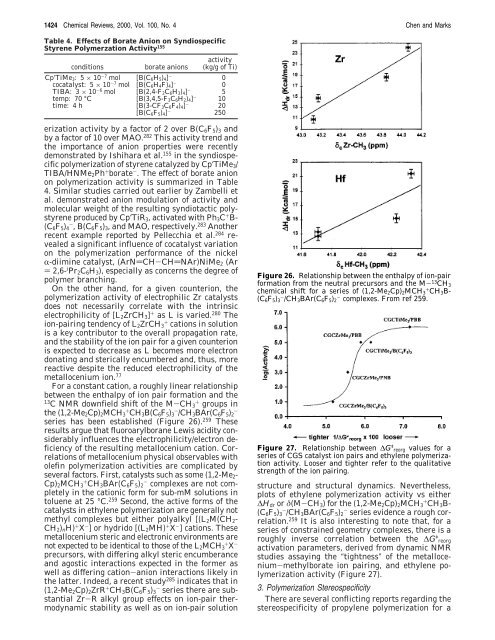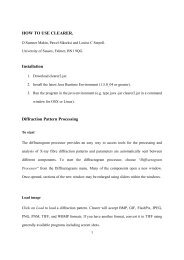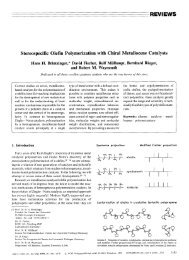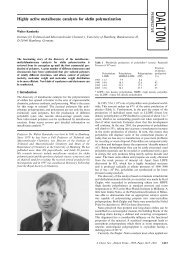Cocatalysts for Metal-Catalyzed Olefin Polymerization: Activators ...
Cocatalysts for Metal-Catalyzed Olefin Polymerization: Activators ...
Cocatalysts for Metal-Catalyzed Olefin Polymerization: Activators ...
You also want an ePaper? Increase the reach of your titles
YUMPU automatically turns print PDFs into web optimized ePapers that Google loves.
1424 Chemical Reviews, 2000, Vol. 100, No. 4 Chen and Marks<br />
Table 4. Effects of Borate Anion on Syndiospecific<br />
Styrene Polymerzation Activity 155<br />
conditions borate anions<br />
activity<br />
(kg/g of Ti)<br />
Cp′TiMe3: 5 × 10-7 mol [B(C6H5)4] - cocatalyst: 5 × 10<br />
0<br />
-7 mol [B(C6H4F)4] - TIBA: 3 × 10<br />
0<br />
-6 mol [B(2,4-F2C6H3)4] - temp: 70 °C [B(3,4,5-F3C6H2)4]<br />
5<br />
- time: 4 h [B(3-CF3C6F4)4]<br />
10<br />
- [B(C6F5)4]<br />
20<br />
- 250<br />
erization activity by a factor of 2 over B(C6F5)3 and<br />
by a factor of 10 over MAO. 282 This activity trend and<br />
the importance of anion properties were recently<br />
demonstrated by Ishihara et al. 155 in the syndiospecific<br />
polymerization of styrene catalyzed by Cp′TiMe3/<br />
TIBA/HNMe2Ph + borate - . The effect of borate anion<br />
on polymerization activity is summarized in Table<br />
4. Similar studies carried out earlier by Zambelli et<br />
al. demonstrated anion modulation of activity and<br />
molecular weight of the resulting syndiotactic polystyrene<br />
produced by Cp′TiR3, activated with Ph3C + B-<br />
(C6F5)4 - , B(C6F5)3, and MAO, respectively. 283 Another<br />
recent example reported by Pellecchia et al. 284 revealed<br />
a significant influence of cocatalyst variation<br />
on the polymerization per<strong>for</strong>mance of the nickel<br />
R-diimine catalyst, (ArNdCH-CHdNAr)NiMe2 (Ar<br />
) 2,6- i Pr2C6H3), especially as concerns the degree of<br />
polymer branching.<br />
On the other hand, <strong>for</strong> a given counterion, the<br />
polymerization activity of electrophilic Zr catalysts<br />
does not necessarily correlate with the intrinsic<br />
electrophilicity of [L2ZrCH3] + as L is varied. 280 The<br />
ion-pairing tendency of L2ZrCH3 + cations in solution<br />
is a key contributor to the overall propagation rate,<br />
and the stability of the ion pair <strong>for</strong> a given counterion<br />
is expected to decrease as L becomes more electron<br />
donating and sterically encumbered and, thus, more<br />
reactive despite the reduced electrophilicity of the<br />
metallocenium ion. 77<br />
For a constant cation, a roughly linear relationship<br />
between the enthalpy of ion pair <strong>for</strong>mation and the<br />
13 C NMR downfield shift of the M-CH3 + groups in<br />
the (1,2-Me2Cp)2MCH3 + CH3B(C6F5)3 - /CH3BAr(C6F5)2 -<br />
series has been established (Figure 26). 259 These<br />
results argue that fluoroarylborane Lewis acidity considerably<br />
influences the electrophilicity/electron deficiency<br />
of the resulting metallocenium cation. Correlations<br />
of metallocenium physical observables with<br />
olefin polymerization activities are complicated by<br />
several factors. First, catalysts such as some (1,2-Me2-<br />
Cp)2MCH3 + CH3BAr(C6F5)2 - complexes are not completely<br />
in the cationic <strong>for</strong>m <strong>for</strong> sub-mM solutions in<br />
toluene at 25 °C. 259 Second, the active <strong>for</strong>ms of the<br />
catalysts in ethylene polymerization are generally not<br />
methyl complexes but either polyalkyl [(L2M(CH2-<br />
CH2)nH) + X - ] or hydrido [(L2MH) + X - ] cations. These<br />
metallocenium steric and electronic environments are<br />
not expected to be identical to those of the L2MCH3 + X -<br />
precursors, with differing alkyl steric encumberance<br />
and agostic interactions expected in the <strong>for</strong>mer as<br />
well as differing cation-anion interactions likely in<br />
the latter. Indeed, a recent study 285 indicates that in<br />
(1,2-Me2Cp)2ZrR + CH3B(C6F5)3 - series there are substantial<br />
Zr-R alkyl group effects on ion-pair thermodynamic<br />
stability as well as on ion-pair solution<br />
Figure 26. Relationship between the enthalpy of ion-pair<br />
<strong>for</strong>mation from the neutral precursors and the M- 13 CH3<br />
chemical shift <strong>for</strong> a series of (1,2-Me2Cp)2MCH3 + CH3B-<br />
(C6F5)3 - /CH3BAr(C6F5)2 - complexes. From ref 259.<br />
Figure 27. Relationship between ∆G q reorg values <strong>for</strong> a<br />
series of CGS catalyst ion pairs and ethylene polymerization<br />
activity. Looser and tighter refer to the qualitative<br />
strength of the ion pairing.<br />
structure and structural dynamics. Nevertheless,<br />
plots of ethylene polymerization activity vs either<br />
∆Hdr or δ(M-CH3) <strong>for</strong> the (1,2-Me2Cp)2MCH3 + CH3B-<br />
(C6F5)3 - /CH3BAr(C6F5)2 - series evidence a rough correlation.<br />
259 It is also interesting to note that, <strong>for</strong> a<br />
series of constrained geometry complexes, there is a<br />
roughly inverse correlation between the ∆G q reorg<br />
activation parameters, derived from dynamic NMR<br />
studies assaying the “tightness” of the metallocenium-methylborate<br />
ion pairing, and ethylene polymerization<br />
activity (Figure 27).<br />
3. <strong>Polymerization</strong> Stereospecificity<br />
There are several conflicting reports regarding the<br />
stereospecificity of propylene polymerization <strong>for</strong> a






